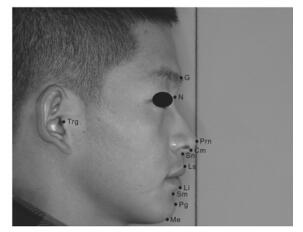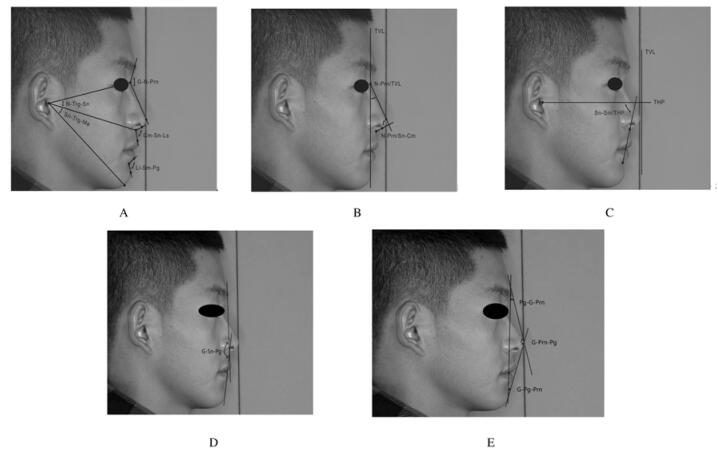扩展功能
文章信息
- 刘畅, 刘莹, 彭慧敏, 韩先卓, 赵忠琪, 王晓琨
- LIU Chang, LIU Ying, PENG Huimin, HAN Xianzhuo, ZHAO Zhongqi, WANG Xiaokun
- 中国北方正常年轻成人自然头位下软组织侧貌角度测量及分析
- Measurement and analysis of soft tissue facial profile of northern Chinese young adults under natural head position
- 吉林大学学报(医学版), 2016, 42(06): 1157-1162
- Journal of Jilin University (Medicine Edition), 2016, 42(06): 1157-1162
- 10.13481/j.1671-587x.20160621
-
文章历史
- 收稿日期: 2016-07-13
2. 吉林大学口腔医院正畸科, 吉林 长春 130021
2. Department of Orthodontics, Stomatology Hospital, Jilin University, Changchun 130021, China
随着社会进步和人们审美水平的不断提高,越来越多的人因要求改善自身形象而就医[1]。在早期,正畸医生只是凭借自身的美学知识和艺术修养来观察和评价人面型的变化,从正畸学的角度来讲,这不够科学,因此越来越多的学者[2-3]开始进行面部软组织侧貌研究。牙颌颅面的种族差异一直是人类学和正畸学领域关注的热点问题。不同人群软组织特征不同[4-5],然而以往研究[6-7]的测量分析大多是以白种人为样本,这些标准值对其他种族的人群不一定适用。自然头位反映了人颅面部真实自然的状态和日常生活中的侧貌美学。研究[8]表明其位置稳定且可靠,可重复性强。目前尚未见关于自然头位下中国北方正常年轻成人软组织侧貌角度分析的研究。本研究针对中国北方正常年轻成人自然头位下的软组织侧貌进行角度测量分析,拟建立一个关于中国北方正常年轻成人软组织侧貌角度值的基本数据库,为正畸和正颌外科医师临床诊治提供依据。
1 资料与方法 1.1 研究对象由2名实验人员于2013年9-11月从吉林大学新民校区近5 000名在校生中进行初步筛选,初步筛选的纳入标准:祖籍为中国北方地区;除第三磨牙外,上下牙列28颗牙齿完整无缺失;双侧第一磨牙均为安氏Ⅰ类关系,前牙覆牙合覆盖基本正常,上下牙列中线与面部中线对正,左右偏差不超过2 mm,牙列拥挤度在4 mm以内;无正畸、正颌、塑形和美容史。排除标准:有颅面部疾病、畸形或不能配合者。依照以上标准初步筛选出研究对象155人,按照严格的拍摄条件拍摄,获得自然头位下的照片。
由5名专业正畸医师和5名从未接受过医学教育的普通人组成评委会对照片进行再筛选。要求评委评选时只关注比例是否协调,排除主观因素如眼睛的影响。至少有5人认为照片的侧貌轮廓协调均衡者被纳入最终的实验研究对象。经过2次筛选,共筛选出实验研究对象113人,其中男性46人,女性67人,年龄18~30岁,男、女性的平均年龄分别为(23.00±1.23)岁和(23.00±1.34)岁。
1.2 主要设备数码相机(Canon Eos500D),微距镜头(Macro Canon Lens 100mm,日本佳能公司),主闪光灯,副闪光灯,三脚架。
1.3 照相方法和体位要求相机调到手动拍摄功能,快门速度1/60 s,光圈f 4.0。研究对象站立于地面固定标志点处,相机与研究对象的距离固定为1.7 m,在研究对象的左前方放置铅垂线和量度标识,确保照片按1:1比例记录。在研究对象的正前方约120 cm处放置一面镜子,以辅助获得自然头位。嘱研究对象口内牙齿处于牙尖交错位,双唇自然放松。为方便定点测量,要求研究对象的额部、颈部和耳部在拍摄时完全暴露不被遮盖。
1.4 定点测量将受试者资料输入计算机内存储,由本文作者在连续的1周内采用Coreldraw软件定点测量。本研究随机选取了30张照片,由本文作者在第一次定点测量后1个月再进行第二次定点测量。计算测量误差,确定测量方法的可重复性。
测量点如下:眉间点(G)、鼻根点(N)、鼻尖点(Prn)、鼻小柱点(Cm)、鼻下点(Sn)、上唇缘点(Ls)、下唇缘点(Li)、颏沟点(Sm)、颏顶点(Pg)、颏下点(Me)和耳屏点(Trg)。见图 1。

|
| G: Most anterior point of middle line of the forehead; N: Most concave point in tissue overlying area of fronto-nasal suture; Prn: Most prominent point of tip of nose; Cm: Most inferior and anterior point of nose; Sn: Point at which nasal septum merges with upper cutaneous lip in mid-sagittal plane; Ls: Point that indicates mucocutaneous limit of upper lip; Li: Point that indicates mucocutaneous limit of lower lip; Sm: Deepest point of inferior sublabial concavity; Pg: Most anterior point of soft tissue chin; Me: Most inferior point of inferior edge of chin; Trg: Most posterior point of auricular tragus. 图 1 1名研究对象的侧貌软组织定点 Figure 1 Landmarks of soft tissue profile of one subject |
|
|
测量项目如下:前鼻角(G-N-Prn)、鼻唇角(Cm-Sn-Ls)、颏唇角(Li-Sm-Pg)、中面角(N-Trg-Sn)、下面角(Sn-Trg-Me),见图 2A;垂直鼻角(N-Prn/TVL)、鼻尖角(N-Prn/Sn-Cm),见图 2B;头部姿势角(Sn-Sm/THP),见图 2C;面凸角(G-Sn-Pg),见图 2D;全面凸角(G-Prn-Pg)、上三角(Pg-G-Prn)和下三角(G-Pg-Prn), 见图 2E。

|
| A: G-N-Prn, Cm-Sn-Ls, Li-Sm-Pg, N-Trg-Sn, and Sn-Trg-Me; B: N-Prn/TVL; C: Sn-Sm/THP; D: G-Sn-Pg; E: G-Prn-Pg, Pg-G-Prn, and G-Pg-Prn. 图 2 1名研究对象的测量项目 Figure 2 Measurement items of one subject |
|
|
采用SPSS17.0统计软件对数据进行统计学分析。经检验实验所得数据符合正态分布。测量方法的可靠性采用Dahlberg’s公式
本研究得到了中国北方正常男女年轻成人自然头位下软组织侧貌角度的测量误差,除鼻唇角(Cm-Sn-Ls)、颏唇角(Li-Sm-Pg)和下面角(Sn-Trg-Me)外,其他角度测量的方法误差均较小。见表 1。
| Measurement method | Measurement error |
| G-N-Prn | 1.11 |
| N-Prn/Sn-Cm | 1.67 |
| N-Prn/TVL | 0.84 |
| Cm-Sn-Ls | 1.73 |
| Li-Sm-Pg | 2.46 |
| N-Trg-Sn | 1.30 |
| Sn-Trg-Me | 1.80 |
| Sn-Sm/THP | 0.32 |
| G-Sn-Pg | 0.61 |
| G-Prn-Pg | 0.75 |
| Pg-G-Prn | 0.66 |
| G-Pg-Prn | 0.34 |
鼻唇角(Cm-Sn-Ls)、颏唇角(Li-Sm-Pg)的标准差比较大。女性前鼻角(G-N-Prn)、鼻尖角(N-Prn/Sn-Cm)、颏唇角(Li-Sm-Pg)、面凸角(G-Sn-Pg)和全面凸角(G-Prn-Pg)的平均值大于男性(P<0.05或P<0.01),而男性垂直鼻角(N-Prn/TVL)、上三角(Pg-G-Prn)的平均值大于女性(P<0.01)。男、女年轻成人自然头位下软组织侧貌角度测量最大值、最小值和平均值见表 2。
| Measurement method |
Minimum value | Maximum value | Mean value | ||||||
| Female | Male | Female | Male | Female | Male | ||||
| G-N-Prn | 128.72 | 115.12 | 154.81 | 152.74 | 145.32±5.10 | 135.37±8.10** | |||
| N-Prn/Sn-Cm | 67.95 | 63.94 | 104.33 | 97.59 | 87.68±7.34 | 83.83±8.31* | |||
| N-Prn/TVL | 19.05 | 20.84 | 35.23 | 39.82 | 26.51±3.52 | 31.12±3.48** | |||
| Cm-Sn-Ls | 82.28 | 72.09 | 123.67 | 122.00 | 99.43±9.93 | 96.85±10.63 | |||
| Li-Sm-Pg | 114.18 | 105.46 | 155.68 | 154.11 | 136.67±9.59 | 131.44±11.04** | |||
| N-Trg-Sn | 24.06 | 24.91 | 33.48 | 38.03 | 29.68±1.93 | 29.42±2.79 | |||
| Sn-Trg-Me | 25.86 | 19.16 | 35.19 | 33.94 | 30.33±2.12 | 30.16±2.48 | |||
| Sn-Sm/THP | 71.57 | 73.86 | 89.68 | 93.82 | 81.57±3.59 | 82.38±4.28 | |||
| G-Sn-Pg | 161.42 | 158.96 | 177.95 | 177.09 | 169.95±3.88 | 167.79±4.02** | |||
| G-Prn-Pg | 136.05 | 133.21 | 153.14 | 149.72 | 144.88±4.18 | 141.81±4.13** | |||
| Pg-G-Prn | 14.51 | 17.00 | 25.15 | 27.89 | 19.17±2.47 | 21.86±2.68** | |||
| G-Pg-Prn | 11.99 | 12.75 | 22.04 | 20.30 | 15.98±2.10 | 16.37±1.93 | |||
| *P<0.05,** P<0.01 vs female. | |||||||||
对美的理解,与一个人的种族背景、生活环境、社会背景和教育背景等均有较大的关系。Auger等[9]对上世纪时尚杂志登出的美貌女性照片进行分析发现:公众更喜欢唇部较突出者。目前尚缺乏对具有个别正常牙合的普通人群颜面侧貌审美的研究。本研究在自然头位下拍摄中国北方正常年轻成人的侧貌照片,对侧貌测量的角度值进行分析,建立一个关于中国北方正常年轻成人软组织侧貌角度值的基本数据库,为正畸及正颌外科临床诊断和制定治疗计划提供参考。
3.2 方法误差分析Dahlberg’s公式是计算重复测量误差的常用方法之一。本研究结果显示:除鼻唇角(Cm-Sn-Ls)、颏唇角(Li-Sm-Pg)和下面角(Sn-Trg-Me)外,各角度测量方法的误差均不大,说明该测量方法可靠。多数研究亦显示鼻唇角和颏唇角的方法误差较大[10]。鼻唇角(Cm-Sn-Ls)、颏唇角(Li-Sm-Pg)和下面角(Sn-Trg-Me)的误差较大可能是由于定点时两点间距离过近所致,也可能与鼻小柱点和颏前点、颏下点不容易定点有关。
3.3 鼻、唇部相关角度分析和性别比较鼻唇部角度有前鼻角(G-N-Prn)、鼻尖角(N-Prn/Sn-Cm)、垂直鼻角(Prn-N/TVL)、鼻唇角(Cm-Sn-Ls)和颏唇角(Li-Sm-Pg)。本研究结果显示:除鼻唇角外,其余4个角均存在明显的性别差异,女性的前鼻角(G-N-Prn)、鼻尖角(N-Prn/Sn-Cm)和颏唇角(Li-Sm-Pg)的平均角度值均大于男性,而男性垂直鼻角(N-Prn/TVL)则大于女性。前鼻角越小说明鼻根点相对其他2点的位置越后缩,鼻根部位置越深。鼻尖角是指鼻背部和鼻基底部所成的角度,该角越大,说明鼻背部向鼻基底部移行的曲线越圆滑,鼻尖部越圆钝。垂直鼻角是指自然头位下鼻背部的突度,该角越大,鼻背部越前突。这3个角度的性别差异一致说明男性的鼻部更加前突、挺拔,而女性的鼻部轮廓曲线更加平缓、柔和。研究[11-13]显示:前鼻角、鼻尖角和垂直鼻角存在明显的性别差异,但Epker[14]则认为前鼻角不存在性别差异。
鼻唇角指鼻基底部和上唇形成的角,鼻唇角和颏唇角是面部侧貌参数中变异度和不确定性较大的参数之一。其可通过正畸或正颌的方法改变,上唇位置和上切牙的唇倾度对其影响比较大。有少数研究者[12-13, 15]发现:鼻唇角存在明显的性别差异;而本研究结果与多数研究一致,认为该角不存在性别差异。
颏唇角指下唇和颏前部形成的角,切牙的唇倾度越小,该角越大。本文作者认为该角存在明显的性别差异,男性的颏沟深度比女性大,男性的颏前部轮廓更为清晰,这与Milosevic等[13]的研究结论一致。
本研究结果显示:鼻唇角和颏唇角的标准差均较大,说明个体之间这些值差异比较大,也可能是因为测量时鼻小柱点和颏前点不容易定点所致。且这2个角度的测量方法误差也较大,基于以上原因,临床应用这2个角度时应慎重、综合考虑。鼻唇角和颏唇角的标准差比较大,即这2个角度的临床参考值不确定性很大,应用时应注意。
3.4 面部轮廓相关角度分析和性别比较面部轮廓相关角度有面中角(N-Trg-Sn)、面下角(Sn-Trg-Me)、头部姿势角(Sn-Sm/THP)、面凸角(G-Sn-Pg)、全面凸角(G-Prn-Pg)、上三角(PgG-Prn)和下三角(G-Pg-Prn)。本研究结果显示:面中角和面下角无明显性别差异,面中角和面下角的角度基本相等,因此认为本研究对象的面中部1/3和面下部1/3基本等高,与既往研究[11-12, 16]结果一致。但Epker[14]则认为下面部高度大于中面部高度。
头部姿势角(Sn-Sm/THP)主要用来评价下面部的侧貌,Fernández-Riveiro等[11]认为该角反映了颏部的位置,该值越大颏部越前突,该值越小颏部越后缩。本研究中该角无明显性别差异,与Malkoç等[17]和Fernández-Riveiro等[11]的研究结果一致。面凸角(G-Sn-Pg)和全面凸角(G-Prn-Pg)反映了面中部相对于整个侧面部的突度。本研究中女性的这2个角的角度平均值明显大于男性,全面凸角的性别差异可能是由于鼻部突度的性别差异所致,但面凸角也存在性别差异,这说明去除鼻部因素,男性的面中部1/3的确比女性前突。而其他研究多认为面凸角不存在性别差异,这可能与民族差异有关系。
Powell等[16]通过对美貌人群面部软硬组织测量分析提出“美学三角”的概念,其可将多个测量指标联系在一起而不需要额外的参考线。本研究中测量的“美学三角”分别为上三角、下三角和前三角,即全面凸角,这与Powell等[16]测量的其他民族的“美学三角”值接近,说明美好面型存在共性,美学三角可作为侧貌美学分析的参考平面。
许多学者均对软组织侧貌进行过研究,所测得的各角度平均值亦不尽相同,其原因可能涉及到种族不同、测量方法不同和年龄不同等,有的研究采用人体测量术或照片测量,有的研究采用X线头影测量。此外,还存在标记点确定和测量的误差问题,这是方法误差大的原因所在。因此,研究时需考虑到这些差异,选择标准相同的研究进行比较,并且在测量前进行统一的标准化培训,规范定点测量的方法。
综上所述,本研究得到了中国北方正常年轻成人自然头位下面部软组织侧貌角度测量的参考值,建立了关于中国北方正常年轻成人软组织侧貌角度测量值的基本数据库,可为正畸和正颌外科的临床诊断治疗提供参考。
| [1] | 李九军, 孙静. 双颌前突患者正畸治疗对美容的影响[J]. 中国实用医药, 2015, 10(7): 126–127. |
| [2] | 周珅玥, 欧平花, 余明珠, 等. 湖南汉族正常牙合成人面部软组织侧貌头影测量分析[J]. 中南大学学报:医学版, 2015, 40(4): 398–404. |
| [3] | 朱鲲, 王娟. 青岛市青少年与北美青少年面部软组织形态比较[J]. 中国美容医学, 2015, 24(4): 59–62. |
| [4] | Hwang HS, Kim WS, McNamara JA. Ethnic differences in the soft tissue profile of Korean and European-American adults with normal occlusion and well-balanced faces[J]. Angle Orthod, 2002, 72(1): 72–80. |
| [5] | Wamalwa P, Amisi SK, Wang Y, et al. Angular photogrammetric comparison of the soft-tissue facial profile of Kenyans and Chinese[J]. J Craniofac Surg, 2011, 22(3): 1064–1072. DOI:10.1097/SCS.0b013e31821075d8 |
| [6] | Miyajima K, McNamara Jr JA, Kimura T, et al. Craniofacial structure of Japanese and European-American adults with normal occlusions and well-balanced faces[J]. Am J Orthod Dentofacial Orthop, 1996, 110(4): 431–438. DOI:10.1016/S0889-5406(96)70047-1 |
| [7] | Gu Y, McNamara Jr JA, Sigler LM, et al. Comparison of craniofacial characteristics of typical Chinese and Caucasian young adults[J]. Eur J Orthod, 2011, 33(2): 205–211. DOI:10.1093/ejo/cjq054 |
| [8] | Peng L, Cooke MS. Fifteen-year reproducibility of natural head posture:a longitudinal study[J]. Am J Orthod Dentofacial Orthop, 1999, 116(1): 82–85. DOI:10.1016/S0889-5406(99)70306-9 |
| [9] | Auger TA, Turley PK. The female soft tissue profile as presented in fashion magazines during the 1900s:a photographic analysis[J]. Int J Adult Orthodon Orthognath Surg, 1999, 14(1): 7–18. |
| [10] | Kale-Varlk S. Angular photogrammetric analysis of the soft tissue facial profile of Anatolian Turkish adults[J]. J Craniofac Surg, 2008, 19(6): 1481–1486. DOI:10.1097/SCS.0b013e318188a34d |
| [11] | Fernández-Riveiro P, Smyth-Chamosa E, Suárez-Quintanilla D, et al. Angular photogrammetric analysis of the soft tissue facial profile[J]. Eur J Orthod, 2003, 25(4): 393–399. DOI:10.1093/ejo/25.4.393 |
| [12] | Anic-Milosevic S, Lapter-Varga M. Analysis of the soft tissue facial profile by means of angular measurements[J]. Eur J Orthod, 2008, 30(2): 135–140. DOI:10.1093/ejo/cjm116 |
| [13] | Milosevic SA, Varga ML, Slaj M. Analysis of the soft tissue facial profile of Croatians using of linear measurements[J]. J Craniofac Surg, 2008, 19(1): 251–258. DOI:10.1097/scs.0b013e31815c9446 |
| [14] | Epker BN. Adjunctive esthetic surgery in the orthognathic surgery patient[M]. Michigan: University of Michigan, 1992: 187-216. |
| [15] | Anic-Milosevic S, Mestrovic S, Prlic A, et al. Proportions in the upper lipelower lipechin area of the lower face as determined by photogrammetric method[J]. J Craniomaxillofac Surg, 2010, 38(2): 90–95. DOI:10.1016/j.jcms.2009.03.013 |
| [16] | Powell N, Humphreys B. Proportions of the esthetic face[M]. New York: Thieme-Stratten, 1984: 72. |
| [17] | Malkoç S, Demir A, Uysal T, et al. Angular photogrammetric analysis of the soft tissue facial profile of Turkish adults[J]. Eur J Orthod, 2009, 31(2): 174–179. DOI:10.1093/ejo/cjn082 |
 2016, Vol. 42
2016, Vol. 42


